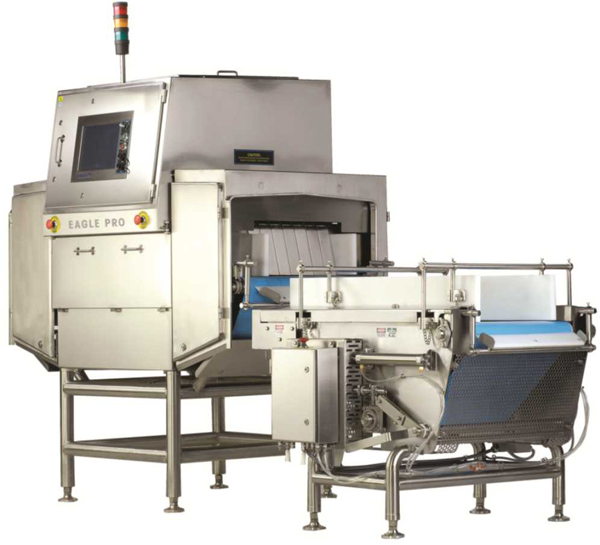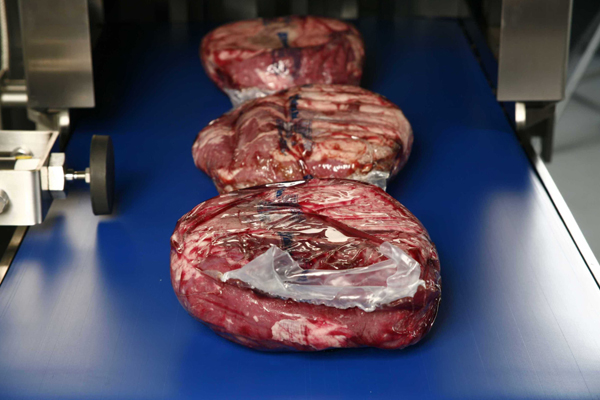Food manufacturing is an ever-changing industry, in which quality and safety are always topics of concern. However, meat and poultry manufacturers face some of the most challenging work environments in the food industry. Traditionally, both their workforce and equipment endure severe environments, with cold temperatures, high levels of humidity and rigorous washdown procedures in place to preserve the quality of the meat or poultry while it is handled on the production line.
Current trends are posing greater challenges to the industry, such as increased sanitization requirements, automation and the use of standard protocols for the efficient interface or exchange of data between process equipment and plant information systems, to enhance traceability throughout the supply chain. Other factors driving change in the industry include retailers’ product quality demands and international market regulations, aimed at ensuring the highest quality and safety standards in an increasingly vigilant regulatory environment.
In order to keep up with such challenges, meat and poultry inspection technology has evolved over the last few years, thanks to the development of X-ray systems that can identify contaminants in diverse products and packages. This article explores some of the current challenges facing the meat and poultry industry, and how X-ray technologies are helping manufacturers meet the strictest product inspection requirements in a timely, safe and cost-effective manner.
Trends in the Meat and Poultry Industry
High levels of equipment sanitization and regular daily hygienic procedures are of vital importance for the industry, to ensure optimum food safety. However, given the difficult work environment of meat and poultry factories, it is not always an easy task. The American Meat Institute (AMI), a trade association that represents 95 percent of red meat producers in the U.S., provides recommendations and standards for the appropriate sanitization of equipment in the meat and poultry industry, with the aim of preventing the presence of potential hazards that could reach the end consumer.
Another important trend within the meat and poultry industry is automation, as computerized equipment increasingly replaces manual work. Currently, automated machinery can perform tasks including inventory management, material handling, quality control and product inspection. Automation improves yield by enhancing control and consistency, reducing the potential for process errors at each stage of production. By limiting the scope for these errors, manufacturers can optimize the process by which raw material is converted to commercial product, ensuring the highest possible levels of raw material utilization and the minimal amount of waste.
Other benefits of automation include reduced risk of contamination due to human error, reduced labor costs, higher productivity and ensured product consistency. This in turn improves sanitization and aids process certification.
Production plants with less people in the work force and more computerized equipment rely on the integration of automation and machinery. This is achieved through standard protocols for communication, such as object linking and embedding (OLE) for process control, known as OPC. OPC provides a common bridge between computing systems and factory floor process control systems, aiding the integration of real-time plant data between control devices from different equipment providers. This allows varied process equipment and product inspection systems to efficiently work together, reducing down time.
Latest Market Regulations
Some of the main changes in regulations driving developments in the meat and poultry industry regard the traceability of products and the accurate labeling of ingredients. As consumers become more aware of nutritional requirements and the procedures concerning product recalls, they exert great influence on regulatory bodies and international organisations regarding food safety.
It is of paramount importance for any food manufacturer to be able to trace the full supply chain journey of their products to ensure that they can identify the source of any food safety problem and take action to both resolve it and prevent its recurrence. The number of product recalls has increased over the last few years in both Europe and the U.S.,[1] resulting from stricter legal requirements, better enforcement of the law and increased consumer wariness of the potential risk of product contamination. In Europe, the European Food Safety Authority states in its General Food Law (Article 18) that authorities and manufacturers must be able to track any food through all stages of production, processing and distribution in order to prevent unsafe foods from reaching consumers.
 In Europe, the General Food Law (GFL) Regulation (2011/05/EC) requires food manufacturers to notify their respective national food regulators within the first 72 hours after any corrective measure takes place. As a result, information about meat and poultry recalls is published and available to consumers. Moreover, the Rapid Alert System for Food and Feed (RASFF) quickly exchanges these notifications between the EU member states. Due to these regulations, it is imperative for manufacturers to be able to trace their products and to avoid any recalls through product inspection, as failure to do so could significantly damage their brand reputation at a global level.
In Europe, the General Food Law (GFL) Regulation (2011/05/EC) requires food manufacturers to notify their respective national food regulators within the first 72 hours after any corrective measure takes place. As a result, information about meat and poultry recalls is published and available to consumers. Moreover, the Rapid Alert System for Food and Feed (RASFF) quickly exchanges these notifications between the EU member states. Due to these regulations, it is imperative for manufacturers to be able to trace their products and to avoid any recalls through product inspection, as failure to do so could significantly damage their brand reputation at a global level.
Changes in U.S. regulations are mostly driven by consumer pressure, with a focus on accurate labeling of ingredients, particularly when it comes to fat and lean content in meat and poultry. The U.S. Food and Drug Administration’s regulations issued in the late 1990s required that the amount of saturated fat and dietary cholesterol levels be listed on food labels. However, the latest regulations included in the “Guidance for Industry: A Food Labeling Guide” also require that labels distinguish between fat, trans fat, cholesterol and lean values. Thus, meat and poultry manufacturers require accurate tools to precisely calculate the percentages of their ingredients, in order to avoid recalls based on the inaccurate reporting of fat content.
An Ally against the Toughest Challenges
Even though these regulations and trends do present difficult challenges for meat and poultry processors, the development of product inspection methods and the latest technological advancements in the field of X-ray technology enable manufacturers to meet the most urgent needs of the industry.
In terms of sanitization, the latest X-ray inspection systems are designed for simple, efficient periodic dismantling and cleaning. Their component parts detach easily—and safely—and are able to withstand the use of alkaline cleaners, chemical oils and rinsing water at high pressures. These features enhance the efficiency of the sanitization cycle and thus are crucial in the fight against the growth of pathogens that could affect the safety of the product and potentially reach the consumer.
Regarding automation, some X-ray inspection equipment in the industry can provide multiple, simultaneous inspections of different lines with conveyor speeds up to 120 feet per minute, for contaminants such as metal, stone, glass, dense plastics and calcified bones. Others are designed for the inspection of high-speed jar, bottle and composite packages, as well as other packaging formats such as larger and upright shapes, eliminating blind spots that commonly occur at the bottom of the container.
 Concerning standard protocols for the integration of machinery in an industrial environment, the latest X-ray systems are network capable, not only allowing the coordination of equipment via standards like OPC but providing remote access. Remote access permits technicians to quickly diagnose and correct issues, reducing downtime and avoiding unnecessary service call costs. This feature becomes increasingly important as production lines now employ X-ray systems as critical control points in their Hazard Analysis and Critical Control Points program and cannot run without this X-ray system being fully operational. X-ray machines with networking capabilities also improve the traceability of products through software that gathers and communicates data, such as barcodes, from different systems and stores it for future reference. There are programs that employ network connectivity for the monitoring of performance statistics, images and reports generated during the X-ray inspection procedure. This advanced software aids meat and poultry manufacturers in case of recall, allowing them to trace a product back to any point on the production line.
Concerning standard protocols for the integration of machinery in an industrial environment, the latest X-ray systems are network capable, not only allowing the coordination of equipment via standards like OPC but providing remote access. Remote access permits technicians to quickly diagnose and correct issues, reducing downtime and avoiding unnecessary service call costs. This feature becomes increasingly important as production lines now employ X-ray systems as critical control points in their Hazard Analysis and Critical Control Points program and cannot run without this X-ray system being fully operational. X-ray machines with networking capabilities also improve the traceability of products through software that gathers and communicates data, such as barcodes, from different systems and stores it for future reference. There are programs that employ network connectivity for the monitoring of performance statistics, images and reports generated during the X-ray inspection procedure. This advanced software aids meat and poultry manufacturers in case of recall, allowing them to trace a product back to any point on the production line.
With respect to the accurate labeling of the fat content of meat and poultry, one of the latest developments in X-ray manufacturing for the measurement of chemical lean (CL) is DEXA, or dual energy X-ray absorptiometry. DEXA is already well known in the medical field and is now used as a non-invasive, inline and real-time method to determine the CL content for meat and poultry products.
In order to determine fat levels, this system uses two X-ray energy spectrums to discriminate between tissue types. It is the most precise method of fat analysis, accurately measuring CL values within ± 1 CL at full line flows. Essentially, DEXA systems measure the amount of X-ray energy absorbed by fat in the meat as it passes through the system. This method satisfies current market demands for greater accuracy in nutritional value labeling, but also helps manufacturers eliminate costly “giveaways” and “fat claim” recalls, substantially improving overall recovery of value in their product. DEXA also measures product weight, readily enabling the packaging of meat products to “point of lean” for a given batch weight or, with additional controls, supporting blending to a target CL or “recipe.”
The Future of the Meat and Poultry Industry
In the future, a continued focus on the accurate labeling of the nutritional value of all food can be expected, making online tools for accurate tissue discrimination and chemical lean measurement (such as DEXA) central to meat and poultry processing. Moreover, technologically advanced countries, such as Japan, will be pushing for even more sensitive detection levels of contaminants, perhaps as small as a 0.3 mm, rather than the current standard of 0.5 mm.
However, as meat and poultry safety regulations evolve, compliance and traceability through each stage of the production line will also grow in importance. In the future, product inspection systems will function as management and process control tools, providing meat and poultry manufacturers with the means to comply and further ensure food safety.
For more information, please visit www.eaglepi.com.
References
1. www.freshfields.com/publications/pdfs/2008/mar10/21238.pdf.



